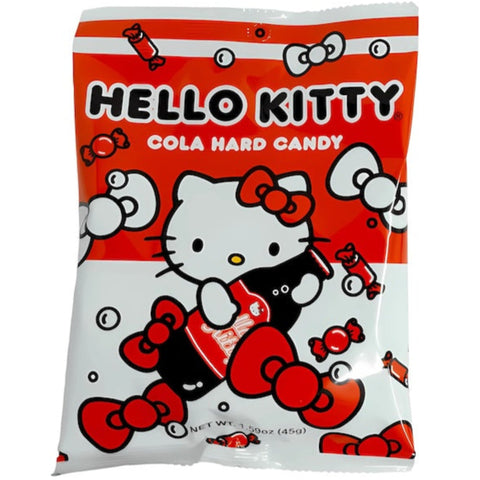Hello Kitty Sanrio Chewy Milk Candy, 2 oz
$2.29
- Description
- Ing & Nutr Facts
- Reviews
- Prop 65 Warning
Yeah! The world needs more Hello Kitty Candy, so here's a whole set! The milk and chocolate milk chewy candy tastes great, like a softer Milkita and has an old school Kasugai milk land feel to it. The strawberry one is like a cross between a gummy and the Hello Kitty marshmallow candy, except that its strawberry all around instead of the jam center. And its pretty sweet, I could only eat a couple. Its kind of elastic texture but doesn't melt as quickly. The kids, they really like this one though.
Choose between Milk (50 g), Strawberry (54 g) and Chocolate (54 g)
CA Residents please see Prop 65 tab above
Nutrition Facts
Serving Size 1 pouch (about 50g)
Serving Per Container 1
| Amount Per Serving | ||
|---|---|---|
| Calories 165 | ||
| % DV (2,000 calorie diet) | ||
| Total Fat 0g | 0% | |
| Saturated Fat 0g | 0% | |
| Trans Fat 0g | ||
| Cholesterol 0mg | 0% | |
| Sodium 0mg | 0% | |
| Total Carbohydrate 40g | 12% | |
| Dietary Fiber 0g | 0% | |
| Sugars 34g | 34% | |
| Protein 1g | 2% | |
| Vitamin A 0% | Vitamin C 0% | |
| Calcium 0% | Iron 0% | |
Ingredients: Sugar, Corn Syrup, Skim Milk Powder, Frozen Strawberry Puree, Gelatin, Glycerin, Powdered Sugar, Citric Acid, Edible Oil and Fat, Strawberry Flavor, Mixfruit Flavor, Glycerin Esters of Fatty Acids Cotton Candy Powder, FD&C Red No. 40
Hello Kitty Sanrio Chewy Milk Candy, 2 oz
I hated the texture of the milk candy. Too gooey
This was my first time ordering with Auntie K and I was pleased with the product, the follow up communication, and the customer service. I will most likely order again in the future.
![]() WARNING: This product can expose you to chemicals such as lead which is known to the State of California to cause cancer. For more information, go to www.P65Warnings.ca.gov
WARNING: This product can expose you to chemicals such as lead which is known to the State of California to cause cancer. For more information, go to www.P65Warnings.ca.gov
What is Proposition 65?
Proposition 65 requires businesses to provide warnings to Californians about significant exposures to chemicals that cause cancer, birth defects or other reproductive harm. These chemicals can be in the products that Californians purchase, in their homes or workplaces, or that are released into the environment. By requiring that this information be provided, Proposition 65 enables Californians to make informed decisions about their exposures to these chemicals. Proposition 65 also prohibits California businesses from knowingly discharging significant amounts of listed chemicals into sources of drinking water. Proposition 65 requires California to publish a list of chemicals known to cause cancer, birth defects or other reproductive harm. This list, which must be updated at least once a year, has grown to include approximately 900 chemicals since it was first published in 1987. Proposition 65 became law in November 1986, when California voters approved it by a 63-37 percent margin. The official name of Proposition 65 is the Safe Drinking Water and Toxic Enforcement Act of 1986.











